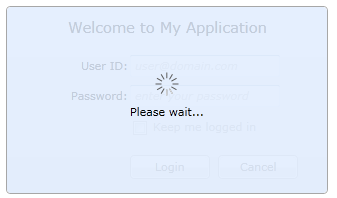

| Intersoft.Client.UI.Controls Namespace : UXBusyIndicator Class |

<StyleTypedPropertyAttribute(Property="OverlayStyle", StyleTargetType=System.Windows.Controls.Border)> <TemplatePartAttribute(Name="ContentElement", Type=System.Windows.Controls.ContentControl)> <TemplatePartAttribute(Name="OverlayElement", Type=System.Windows.Controls.Border)> <StyleTypedPropertyAttribute(Property="DecoratorStyle", StyleTargetType=System.Windows.Controls.Border)> <DescriptionAttribute("Represents a content control that displays an indicator when busy.")> <TemplatePartAttribute(Name="BusyIndicatorElement", Type=System.Windows.Controls.Grid)> <TemplatePartAttribute(Name="RootElement", Type=System.Windows.Controls.Grid)> <TemplatePartAttribute(Name="BusyIndicatorPresenter", Type=System.Windows.Controls.Grid)> <TemplatePartAttribute(Name="DefaultBusyIndicator", Type=System.Windows.Controls.Grid)> Public Class UXBusyIndicator Inherits Intersoft.Client.Framework.ISContentControl Implements Intersoft.Client.Framework.IControl, Intersoft.Client.Framework.IFramework, Intersoft.Client.Framework.ILicensing
Dim instance As UXBusyIndicator
[StyleTypedPropertyAttribute(Property="OverlayStyle", StyleTargetType=System.Windows.Controls.Border)] [TemplatePartAttribute(Name="ContentElement", Type=System.Windows.Controls.ContentControl)] [TemplatePartAttribute(Name="OverlayElement", Type=System.Windows.Controls.Border)] [StyleTypedPropertyAttribute(Property="DecoratorStyle", StyleTargetType=System.Windows.Controls.Border)] [DescriptionAttribute("Represents a content control that displays an indicator when busy.")] [TemplatePartAttribute(Name="BusyIndicatorElement", Type=System.Windows.Controls.Grid)] [TemplatePartAttribute(Name="RootElement", Type=System.Windows.Controls.Grid)] [TemplatePartAttribute(Name="BusyIndicatorPresenter", Type=System.Windows.Controls.Grid)] [TemplatePartAttribute(Name="DefaultBusyIndicator", Type=System.Windows.Controls.Grid)] public class UXBusyIndicator : Intersoft.Client.Framework.ISContentControl, Intersoft.Client.Framework.IControl, Intersoft.Client.Framework.IFramework, Intersoft.Client.Framework.ILicensing
[StyleTypedPropertyAttribute(Property="OverlayStyle", StyleTargetType=System.Windows.Controls.Border)] [TemplatePartAttribute(Name="ContentElement", Type=System.Windows.Controls.ContentControl)] [TemplatePartAttribute(Name="OverlayElement", Type=System.Windows.Controls.Border)] [StyleTypedPropertyAttribute(Property="DecoratorStyle", StyleTargetType=System.Windows.Controls.Border)] [DescriptionAttribute("Represents a content control that displays an indicator when busy.")] [TemplatePartAttribute(Name="BusyIndicatorElement", Type=System.Windows.Controls.Grid)] [TemplatePartAttribute(Name="RootElement", Type=System.Windows.Controls.Grid)] [TemplatePartAttribute(Name="BusyIndicatorPresenter", Type=System.Windows.Controls.Grid)] [TemplatePartAttribute(Name="DefaultBusyIndicator", Type=System.Windows.Controls.Grid)] public ref class UXBusyIndicator : public Intersoft.Client.Framework.ISContentControl, Intersoft.Client.Framework.IControl, Intersoft.Client.Framework.IFramework, Intersoft.Client.Framework.ILicensing
UXBusyIndicator is inherited from ISContentControl, which means that it can contain a single object of any types, such as a string, an image, or a panel. For more information about content model, see Content Model Overview.
You use UXBusyIndicator control to provide an easy way to show a busy visual hint on top of the content when the application is in progress executing a long running task, such as retrieving data, logging in, or saving a record.
UXBusyIndicator is designed as a content control, this means that you generally put the content inside the control, such as shown in the following example.
| XAML |
Copy Code
|
|---|---|
<Intersoft:UXBusyIndicator> <Intersoft:DockPanel Width="300" Height="200"> <TextBlock Text="Welcome to My Application" HorizontalAlignment="Center"/> </Intersoft:DockPanel> </Intersoft:UXBusyIndicator> |
|
UXBusyIndicator displays a busy visual hint when the control is busy, which is done by setting the IsBusy property to true. You can also easily add a custom content to the busy indicator, such as showing a "Loading..." text, or other content that suitable to your application's context.

For more information about UXBusyIndicator, see UXBusyIndicator Overview.
System.Object
System.Windows.DependencyObject
System.Windows.UIElement
System.Windows.FrameworkElement
System.Windows.Controls.Control
System.Windows.Controls.ContentControl
Intersoft.Client.Framework.ISContentControl
Intersoft.Client.UI.Controls.UXBusyIndicator
Target Platforms: Windows 7, Windows Vista SP1 or later, Windows XP SP3, Windows Server 2008 (Server Core not supported), Windows Server 2008 R2 (Server Core supported with SP1 or later), Windows Server 2003 SP2